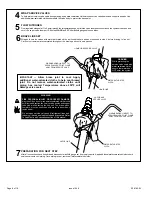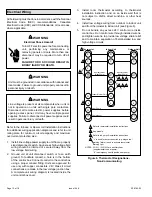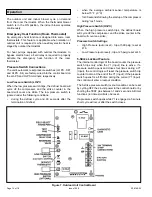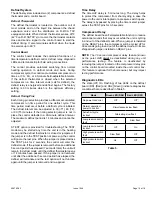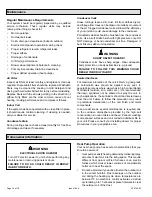
Page 17 of 18
506762-03
Issue 1946
Indicating Light
Most heat pump thermostats have an amber light
which indicates when the heat pump is operating in the
emergency heat mode.
Temperature Indicator
The temperature indicator displays the actual room
temperature.
Important System Information
• Your system should never be operated without a clean
air filter properly installed.
• Return air and supply air registers should be free from
restrictions or obstructions to allow full flow of air.
IF YOUR SYSTEM DOES NOT WORK, BEFORE
REQUESTING A SERVICE CALL:
1. Ensure thermostat is set below (cooling) or above
(heating) room temperature and that the system lever
is in the “COOL”, “HEAT” or “AUTO” position.
2.
Inspect your return air filter: If it is dirty, your heat pump
may not function properly.
3. Check indoor and outdoor disconnect switches.
Confirm circuit breakers are ON or that fuses have not
blown. Reset breakers/replace fuses as necessary.
4. Inspect the outdoor unit for clogged condenser coils,
(grass cuttings, leaves, dirt, dust or lint). Ensure that
branches, twigs or other debris are not obstructing the
condenser fan.
IF YOUR SYSTEM STILL DOES NOT OPERATE,
CONTACT YOUR SERVICING DEALER.
Be sure to describe the problem, and have the model and
serial numbers of the equipment available.
If warranty replacement parts are required, the warranty
must be processed through a qualified distribution location.
• During the defrost cycle, you may notice steam rising
from the outdoor unit. This is a normal occurrence.
The thermostat may engage auxiliary heat during the
defrost cycle to satisfy a heating demand; however,
the unit will run to normal operation at the conclusion
of the defrost cycle.
In case of extended power outage...
If the outdoor temperature is below 50°F and power to your
outdoor unit has been interrupted for one hour or longer,
observe the following when restoring power to your heat
pump system.
• Set the room thermostat selector to the “Emergency
Heat” setting to obtain temporary heat for a minimum
of 6 hours. This will allow system refrigerant pressures
and temperatures enough time to return to a stabilized
condition.
• In Emergency Heat mode, all heating demand is
satisfied by auxiliary heat; heat pump operation is
locked out. After a 6 hour “warm-up” period, the
thermostat can then be switched to the “Heat” setting
and normal heat pump operation may resume.
Thermostat Operation
The wall-mounted thermostat controls your heat pump.
The thermostat is available in various configurations from
different manufacturers. The information below is typical for
most thermostats. Ask your dealer for specific information
regarding the model of thermostat installed.
Fan Switch
In AUTO or INT (intermittent ) mode, the blower operates
only when the thermostat calls for heating or cooling. This
mode is generally preferred when humidity control is a
priority.
The ON or CONT mode provides continuous indoor
blower operation, regardless of whether the compressor or
auxiliary heat are operating. This mode is required when
constant air circulation or filtering is desired.
On models without a fan selection switch, the fan will cycle
with the outdoor unit.
System Switch
Set the system switch for heating, cooling or auto
operation. The auto mode allows the heat pump to
automatically switch from heating mode to cooling mode to
maintain predetermined comfort settings. Many heat pump
thermostats are also equipped with an emergency heat
mode which locks out heat pump operation and provides
temporary heat supplied by the auxiliary heat.






